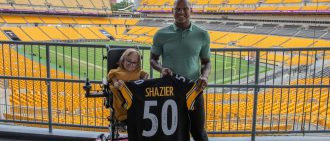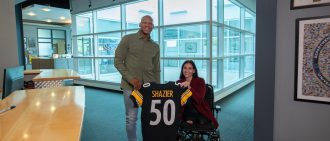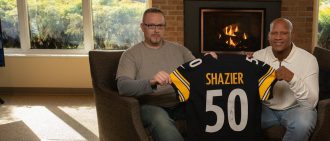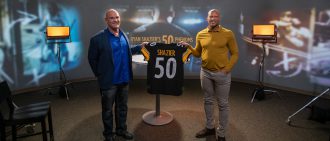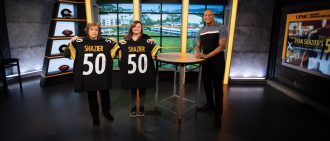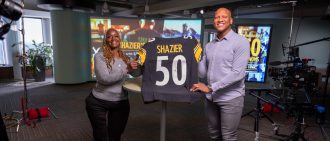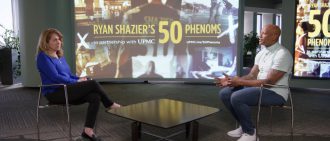When Chris Hahn needs a little motivation, he pulls out his phone.
That’s where he keeps the images of the brain scans that show the brain tumor he used to have.
“When I start training, if I feel lazy, I make that the screensaver on my phone,” he says. “So every time I look at my phone, I realize how blessed and how lucky I am that I could do what I do today based on what happened back then.”
A former professional wrestler, Chris experienced severe headaches, ongoing blackouts, and other symptoms. Believing his symptoms stemmed from concussions, he enrolled in a concussion study at UPMC.
It turned out that his problems came from a different source: a brain tumor the size of a tennis ball. The study helped him get in the door at UPMC, where an innovative surgery removed his tumor and cured his symptoms.
Today, Chris is an actor and stuntman. He’s thankful for the second chance he received.
“It was a life-changing experience, not only physically, but mentally and spiritually,” he says. “It’s really changed my world.”
Ryan Shazier's 50 Phenoms Season 4
‘It Didn’t Agree with Me Too Well’
A native of Mansfield, Ohio, Chris wrestled professionally under the name Johnny Paradise. He wrestled for the World Wrestling Federation (WWF), World Championship Wrestling (WCW), and Extreme Championship Wrestling (ECW).
In his second professional match, he wrestled the Road Warriors, a legendary tag team, in front of 45,000 people. The next night, he faced another professional wrestling legend, the Undertaker.
“That’s a good way to break your career in, you know?” he says.
As the years and the matches piled up, so did the injuries. Chris says doctors have told him he’s had more than 30 concussions in his life. He says he’d go to the locker room seeing stars, but he’d always shake it off.
“I know it sounds kind of ridiculous, like, ‘Why would you let someone hit you in the head with a chair?'” he says. “But there are ways around the head getting hit because you throw your arms up and you can take the brunt of the blow with your forearms and stuff.
“But it’s the jarring of the head, and when I hit the mat, smacking the back of my head, and the constant bouncing around of my brain. After 28 years, it didn’t agree with me too well. I don’t think it’d agree with anybody too well.”
During a May 2014 match, Chris hit his head on a steel railing around the outside of the ring. That started a months-long ordeal of neurological symptoms that eventually led Chris to UPMC.
Never Miss a Beat!
Join the email list and receive updates for Ryan Shazier's 50 Phenoms.
Thank you for subscribing!
You can now select the specific newsletters you'd like to receive.
You are already subscribed.
Subscribe to more newsletters in our email preference center.
Sorry, an error occurred. Please try again later.
Get Healthy Tips Sent to Your Phone!
‘Something Wasn’t Right’
Over the spring and fall of 2014, Chris experienced ongoing symptoms, including severe headaches, tremors, and blackouts. He recalls waking up dizzy and in pain, crawling to his bathroom to get pain medicine, going back to bed, and waking up later symptom-free.
Despite the ongoing problems, Chris didn’t seek treatment for several months.
“Being a professional wrestler and being an athlete my whole life, I’ve always thought I was invincible. Nothing could hurt me,” he says. “And so when I’d get these headaches, I always thought they’d go away.”
In September 2014, he finally saw a doctor and received a prescription for an anti-seizure medicine. Although the medication masked his symptoms, they didn’t go away.
Late that fall, Chris was working a temporary job for a friend where he loaded large trash items into a truck to haul away. One morning, he was working the job when he felt a blackout spell coming on.
“I sat on the tailgate and passed out, and I woke up underneath the running truck,” he says. “That’s when I realized that something was wrong. I had to do something because I knew that something wasn’t right.”
‘A Shocking Finding’
After the incident with the truck, Chris reached out to his mother. Worried, she began searching for a way to help her son.
In her research, Chris’ mother learned of a study at UPMC and the University of Pittsburgh School of Medicine that could potentially help him. The study was researching the effects of concussions and traumatic brain injuries in military veterans and professional athletes.
Chris’ mother contacted the researchers to see if Chris qualified. At the time, he didn’t have health insurance; but because the Department of Defense was funding the study, that wasn’t an issue. Chris came to Pittsburgh in December 2014 to begin the study.
“He was a very memorable guy: very boisterous, very appreciative to be here at Pitt,” says Kate Edelman, MS, senior research project manager, Neurotrauma Clinical Trials Center (NCTC), University of Pittsburgh, and one of the leaders of the study.
The study consisted of various tests of brain health, including cognitive and physical testing and a sleep evaluation.
The team also took scans of Chris’ brain. There, they came across “a shocking finding”: a tennis ball-sized tumor, also known as a meningioma, over his right eye.
Meningiomas are the most common type of skull-based tumor. Depending on their size and location, they can cause different symptoms. Most meningiomas are noncancerous, but some can be malignant.
In Chris’ case, his tumor wasn’t cancerous, but it was large — and it was affecting the right front part of his brain. Along with the physical symptoms like his headaches and dizziness, the tumor was causing personality effects.
“His story, his medical history, perfectly fit the pattern that we see with people who have suffered from a series of concussions over time and continue to have issues related to those concussions,” says David Okonkwo, MD, director, Neurotrauma Clinical Trials Center, and clinical director, Brain Trauma Research Center, UPMC. “And so our assumption was that we would go through this process and we would end up helping him with those lingering consequences of a concussion.
“We had no idea whatsoever that the driving force was going to be a very large brain tumor.”
Dr. Okonkwo brought Chris’ case to Paul Gardner, MD, a UPMC neurosurgeon who specializes in minimally invasive procedures for tumors around the base of the skull.
“The entire right front part of his brain wasn’t functioning,” says Dr. Gardner, Peter J. Jannetta Endowed Chair of Neurological Surgery, University of Pittsburgh School of Medicine, and director, Center for Skull Base Surgery, UPMC. “It was putting pressure on the rest of his brain, which in some cases can cause pretty significant damage, and it can be life-threatening. It had not gotten to that point in his case, but it can be life-threatening.”
Chris’ tumor had been growing for years, yet he was able to carve out his professional career in spite of it. The tumor’s size and location did make him more vulnerable to the effects of concussions.
“Imagine having a tumor there that’s taking up space,” Dr. Gardner says. “It leaves less space, and the brain is swollen or almost concussed at baseline. So because it’s so swollen, the brain has less of an ability to tolerate another injury.”
The team began to prepare Chris for surgery within 72 hours. He recalls he “kind of freaked out” when he learned he would need major brain surgery.
“The night before my surgery, I basically cried myself to sleep,” he says.
‘It Was Kind of Overwhelming’
The typical surgery for a meningioma removal is a craniotomy using a large incision across the top of the head. That presented a small issue from a cosmetic standpoint because Chris had interest in working on camera.
“We had to take out an enormous brain tumor and use an incision — in a bald man — such that anyone watching a movie that he starred in would never have any clue that he had had brain surgery,” says Dr. Okonkwo, who assisted Dr. Gardner on the surgery.
They found a solution in the distinct furrows Chris has in his forehead. Dr. Gardner made his incision through those wrinkles and performed the surgery. The procedure took several hours, but Dr. Gardner was able to remove the whole tumor.
Before Chris went under, he posted about his surgery on social media. He woke up to more than 4,000 well-wishes and other messages.
“It was kind of overwhelming,” he says.
Even with the surgery behind him, Chris faced a long recovery. It can take several months for the brain swelling to go down.
From a physical standpoint, though, Chris’ athletic background helped him. He was up and walking around the hospital with supervision just hours after his surgery.
As his rehab continued, a friend of Chris’ would take him to a local gym, where he would walk laps. He progressed to using a bike and eventually lifting weights. Chris followed his doctors’ advice as he rehabbed, progressing step by step.
“Chris was amazing in (his recovery) journey,” Dr. Okonkwo says. “He was so grateful for getting a second chance at life that he embraced his recovery with all the verve and flare you would expect from someone who made a living in a wrestling ring.”
There was one sticking point: Dr. Okonkwo told Chris he could not return to wrestling after his surgery. But Chris knew a friend in Los Angeles who worked in stunts for television shows and movies. That friend told Chris he should consider stunt work and assured him it would be safe. After hearing the same message from other stunt professionals, Chris contacted Dr. Okonkwo.
“I cleared everything through him,” Chris says. “He said, ‘The No. 1 thing is no head shots. If you’re going to fall, make sure you have a neck pad or a neck roll on. And just be smart. You know what you can and can’t do.'”
‘I’ve Been Pretty Blessed’
Immediately after the surgery, Chris says his forehead looked like he was “carved open like a Thanksgiving day turkey.”
Today, there’s almost no evidence he had major brain surgery. That’s good news for someone who appears on camera as often as Chris does.
In less than a decade since his surgery, Chris has appeared in numerous television and film products as an actor and stuntman. He’s performed alongside some of Hollywood’s brightest stars, including Zac Efron, Jeremy Renner, Ryan Reynolds, and Dwayne “The Rock” Johnson.
“One of the most rewarding things is to see someone get back to doing what they want to do and what they love or without any restriction whatsoever,” Dr. Gardner says. “And that’s our ultimate goal.”
As much as Chris enjoys his acting and stunt work, he finds some of his other work more rewarding. He works as a personal trainer and as a fitness life coach for nonviolent drug offenders. Other parts of the program include education and job training to help them find the right path.
“I can tell these young guys, you know what, you’re down on your luck,” he says. “But if you put your mind to it and you get motivated, if you have a passion and desire to do something, you can do whatever you want.”
Chris knows that from personal experience. While his surgery helped his physical symptoms, it also changed him mentally.
Before surgery, Chris says he was arrogant; he uses a few choice expletives to describe himself. Post-surgery, he strives to do everything he can to help others — whether it’s his life coach job or as an advocate for UPMC.
After the concussion study Chris took part in concluded, UPMC took the data and created a similar study for former NFL players. Edelman says Chris “dropped everything” and helped with recruitment. The UPMC studies have helped many people who are struggling with the effects of concussion and tramatic brain injury.
“He’s very appreciative, and he understands what he’s been given and he doesn’t stop giving back,” Edelman says.
Now at 51 years old, Chris has a wife and a family. He knows the second chance he received, and he wants to make the most of it.
“I’ve been pretty blessed,” he says. “This incident that happened to me was a life-changing experience, and it made me actually respect and learn more about life and how I live life now.
“My motto is, if I can put a smile on somebody’s face every day, it was a successful day.”
About UPMC
Headquartered in Pittsburgh, UPMC is a world-renowned health care provider and insurer. We operate 40 hospitals and 800 doctors’ offices and outpatient centers, with locations throughout Pennsylvania, Maryland, New York, West Virginia, and internationally. We employ 4,900 physicians, and we are leaders in clinical care, groundbreaking research, and treatment breakthroughs. U.S. News & World Report consistently ranks UPMC Presbyterian Shadyside as one of the nation’s best hospitals in many specialties and ranks UPMC Children’s Hospital of Pittsburgh on its Honor Roll of America’s Best Children’s Hospitals. We are dedicated to providing Life Changing Medicine to our communities.
